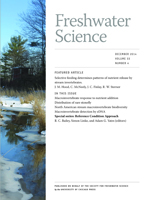The status of biological assemblages is often inferred by comparing observational assemblage data with reference data generated by a predictive model. Limiting environmental difference analysis (LEDA) applies the ecological concepts of distance decay of similarity and limiting factor theory to model reference data by extrapolation from samples collected at reference sites. I applied LEDA modeling to data sets from the Australian Capital Territory (ACT), Laurentian Great Lakes (GL), and Canadian Yukon Territory (YT) to test its accuracy and precision in predicting the composition of benthic macroinvertebrate samples from reference sites, and its specificity and sensitivity in detecting mathematically simulated human impacts on sample composition. LEDA models were significantly and substantially more accurate than null models for all 3 data sets, but not significantly more precise. They mostly assessed unimpacted samples correctly but seldom detected mild simulated impacts. However, they often detected moderate and usually detected severe impacts. Model performance for the test data sets probably was constrained by limitations of the environmental predictor variables and low taxonomic richness in many samples. The simulated impacts provided insight into model behavior but were limited in their scope and realism. I suggest that future simulations should separately test detection of different kinds of assemblage change, not only different intensities, and should address the consequences of human alteration of predictor variables.
BioOne.org will be down briefly for maintenance on 17 December 2024 between 18:00-22:00 Pacific Time US. We apologize for any inconvenience.
How to translate text using browser tools
15 September 2014
Predicting Reference Assemblages for Freshwater Bioassessment with limiting Environmental Difference Analysis
Bruce C. Chessman
ACCESS THE FULL ARTICLE
It is not available for individual sale.
This article is only available to subscribers.
It is not available for individual sale.
It is not available for individual sale.

Freshwater Science
Vol. 33 • No. 4
December 2014
Vol. 33 • No. 4
December 2014
bioassessment
freshwater
limiting factor
macroinvertebrate
predictive model




